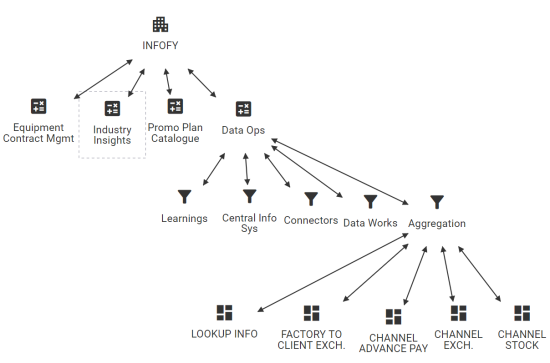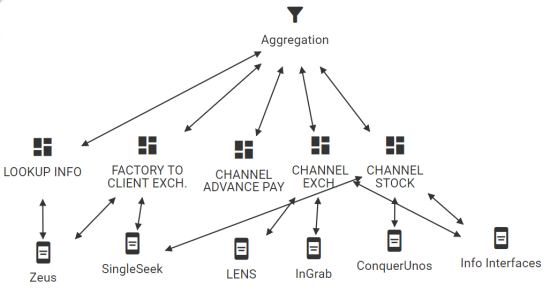Align IT Solutions with Business Capabilities
Alignment of IT solutions with business capabilities is the fundamental building technique for an effective and efficient enterprise. If you follow this path carefully, you can form a composable enterprise and rationalize IT systems. Take the opposite route, and you will have to deal with an overhead of the tangled knowledge, processes, and interactions within the organization. Furthermore, disconnect between the business and IT often results in the development and deployment of software systems that duplicate the available functionality, are not a good fit for the business purpose or usage, and thus fail to deliver value to the end-users and customers.
In this use case, let us try to analyze the data of an existing organization and reason about the rationality of the IT solutions to deliver against business objectives.
Step One: Define Business Architecture
Let's go back to the foundation of an organization. First comes the vision and business capabilities, and then we build IT solutions to support those fundamental elements. It is not the other way around since nobody would create a solution without the vision and demand. We can't emphasize enough the importance of such an approach, as its outcomes must feed into the enterprise and solution architecture disciplines.
We look at a business architecture as a top-down graph of elements describing the company and its offerings. We can expand the latter to categorize the capabilities into logical groups and define problem subdomains that speak the language of the business. Since we will be using Archipeg EA Framework v1.0 for this exercise, let us adjust the terminology and ontology accordingly to avoid confusion.
Here is how our business architecture's graph schema looks, from top to bottom:
- Company is the top-most element that represents an organization or an enterprise that we are modeling.
- The company delivers solutions to its customers or target markets and industries, so the solutions are the second-level tiers of the knowledge. e.g., a company may be involved in two distinct kinds of businesses, like Amazon provides e-commerce and cloud solutions via amazon marketplace and AWS accordingly. Most small-size organizations only target a single segment, and thus having only one solution is a common situation.
- Within a solution, we define capabilities that customers can recognize, consume, demand, or relate. e.g., Amazon's e-commerce solution exposes the capabilities of product selection, comparison, payments, shipments, and so on.
- If we further drill into a single capability, we can specify what features the applications will implement here. e.g., the payments capability allows using a visa and other popular processors and saving and reusing the preferred payment methods.
Now, let us see how one specific company, InfoFy, has structured its business capabilities by incorporating the above ontology. The below picture is taken from Archipeg's Graph Explorer view, and for simplicity, we have only drilled down to a single capability. If we were to expand all the elements, you can see that we would have a top-down graph of the knowledge, from the company down to the features, as we said earlier.

If your business architecture looks somewhat similar to the above picture, you must have gotten it right. If the features intersect among capabilities, you may need to incorporate rationalization techniques for this work area. However, since we are focusing on the IT solution alignment, we will leave other issues out of the scope and continue with our journey.
Step Two: Align IT Solution Architecture
When building IT solutions, one must examine the business architecture that the IT needs to support. Alignment under the business does not only mean cherry-picking and fulfilling random capabilities in the delivered systems. It also means to align boundaries with the functions. To uncover misalignment, pay attention to red flags such as:
- Does each capability or feature have a single implementing application? If you have two or more associated elements, maybe there is a duplication of efforts and the subsequent overhead.
- Does each IT system support a single capability or feature? There is an overhead of complexity if you have multiple answers since the business looks different from the solutions. To explain the mentioned point better, the company must be re-composable as lego blocks (i.e., composability of business architecture). When you need to reshuffle things, you need to do so for both the business and the IT solution architecture simultaneously. This task becomes challenging and often impossible if the boundaries do not match on the two sides of the fence.
Visual architecture tools make it possible to analyze large-scale IT-to-business alignment and composability. In our case, since we have Archipeg at our service, we can expand the bottom-side feature associations and see which IT systems fulfill those. Below is the result of the expansion, after omitting the rest of the details irrelevant at this point.

As you can see, things don't look so organized and sound anymore. Some applications fulfill multiple features, endangering the composability of the enterprise. On the other hand, some features are present in numerous systems, revealing duplications and overhead. Perhaps, InfoFy is a company with a long history of existence, and what we see is how things evolved organically. Maybe now is the right time to plan the digital transformation to lower costs and optimize efficiency and composability?
Wrap Up
Some of the above constraints can differ from one organization to another, such as how you describe your business capabilities or what constitutes proper alignment. Once you have gained clarity in such subjects, it is time to measure and gauge the alignment effectiveness. Outcomes of the above exercise can change with time, so it is a rule of thumb to repeat it regularly and review the health of your enterprise and solution architecture.
We conducted the above use case via Archipeg - Cloud-Based Digital Enterprise Architecture Tool. If you have similar challenges, give it a try with a free 30-day trial and transparent prices. Let us know if you have any questions or need help, and we will be glad to cooperate.
See Also